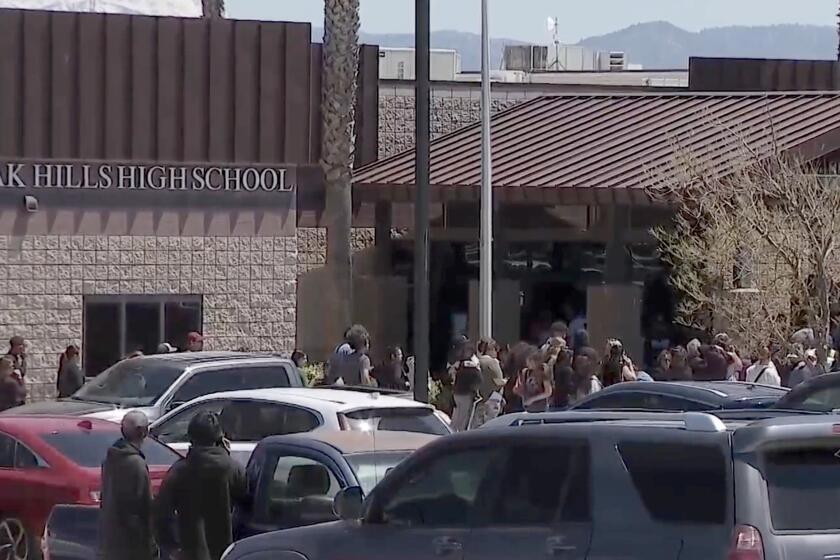Uneasy Riders
Bob Douglas has been riding Orange County buses for 15 years and knows the system--in his words--”like the back of my hand.”
But that may change if a major “straight-lining” of bus routes goes into effect in June, the most massive overhaul of the system in history. At a public hearing today, advocates for the disabled and the elderly plan to be out in force to protest the changes and demand answers to how the new routes would affect them.
Orange County Transportation Authority officials have said the overhaul is needed to modernize one of the nation’s fastest-growing bus systems. Planners say that in order to expand service over the next decade, the kinks must be worked out in a system where bus routes now overlap nearly 40% of the time.
“We believe the whole structure needs to be changed in order to better serve the county,” said transit agency spokesman Dave Simpson.
To date, transit officials have received more than 1,000 comments about the plans, with a majority of people saying they’re worried about the changes, Simpson said.
For 46-year-old Douglas and the 10,000 or so other developmentally disabled people in Orange County, any change to the bus system that is their lifeline can be alarming. And under the proposal, nearly all of the county’s 72 routes would be affected. Several routes would be eliminated and some new lines would be added. The idea is to create a more grid-like system on the county’s main thoroughfares to replace the often-winding routes through residential neighborhoods.
Advocates for the disabled say that may mean that thousands of disabled riders will need to be retrained to adapt to the new system, a process that--depending on the individual’s needs and abilities--can take as long as three weeks.
In a letter to the transportation authority this month, the local chapter of the Developmental Disabilities Board urged the board to hold off on changes until such issues could be resolved. A “great many” bus riders with cognitive or mobility problems might not be able to navigate a bus system that would require more transfers, warned Chris Hill, the board’s chairman.
Determining how many riders will need such help is impossible right now, advocates say, because the transit agency has not provided complete route maps or timetables for the proposed straight-lined system.
“I don’t know what it’s going to mean yet,” said Andrea Erickson, executive director for Project Independence, a Costa Mesa-based program for the developmentally disabled. “For some people it’s going to be easier. For some people, more difficult. And the question is: How much more difficult? Is it going to cost a person a job? Will they have to move?”
Kyle Minnis, 29, said the proposed changes would make his life more difficult. Minnis, who works as the consumer advocate for Orange County’s disabled residents, said the line he relies on most, Route 69, will be eliminated.
Minnis, who has cerebral palsy and has been in a wheelchair since he was 13, said that he will have to take three buses instead of one from his home in Santa Ana to Cal State Fullerton.
“As you transfer more in an electric wheelchair, you are dependent on the lifts,” he said. “This means that instead of being dependent on lifts two times a day, I’ll have to use the lift six times during my trip.”
Minnis said he and others will testify Monday.
“The word is out on this thing,” he said. “We feel we’ll be very organized at the public hearing.”
Transit officials say they know that the changes may be difficult for some riders--30% may see longer commute times--but say 60% will save time. Still, they say, such a significant adjustment has a ripple effect on everyone. Jodi Sorrell, the transportation authority’s marketing administrator, has said it is the equivalent of motorists waking up one morning to find that all the streets have been changed.
*
Officials say that if board members vote in March to go forward with the changes, they will work with the elderly and the disabled to get them comfortable with the new routes. Already, transit officials say they have made an adjustment in plans for Route 42, which serves the Braille Institute in Anaheim. After complaints that eliminating the school’s side-street bus stop would be dangerous, transit officials visited the site and agreed.
Now they plan to continue to provide at least some direct service to the school. For a regular bus rider like Douglas, who takes three buses from his family’s home in Santa Ana to his job at Project Independence in Costa Mesa, the change might not be too bad. Since he reads well and can use the thick book of bus schedules with some expertise, Douglas may be better able to cope than others.
Still, he knows what can happen when he takes an unfamiliar route. Once it took him more than four hours to get home when he boarded the wrong bus and didn’t realize his mistake for miles.
“It zigzags now,” he said of the bus routes, pointing out one pictured in the book. “I like it better when it zigzags.”
More to Read
Start your day right
Sign up for Essential California for news, features and recommendations from the L.A. Times and beyond in your inbox six days a week.
You may occasionally receive promotional content from the Los Angeles Times.







